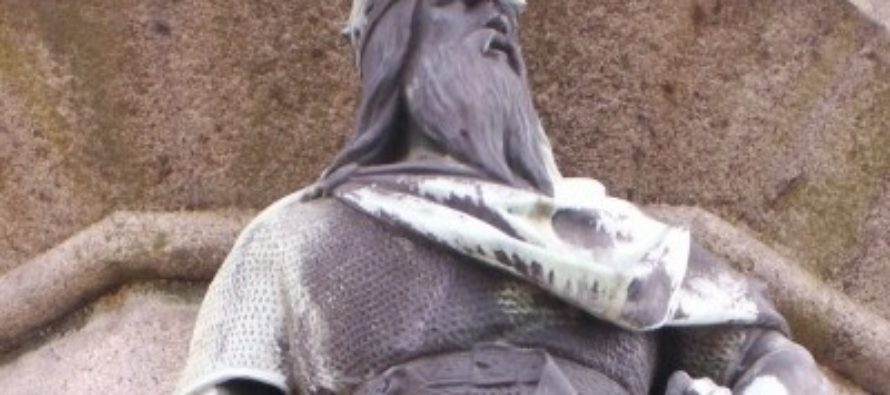Viking is ‘forefather to British royals’? Norwegian-French investigation hopes to reveal that Norwegian Viking noble Ganger Hrólf was the same person as Rollo, the first Duke of Normandy

NordenBladet – A joint Norwegian-French investigation hopes to reveal that Norwegian Viking noble Ganger Hrólf was the same person as Rollo, the first Duke of Normandy – and the forefather of the British royal family.
Rollo*, sometimes known as Robert I, is estimated to have lived between 846 and 931 AD, and was the first ruler of a Viking settlement in France that later became Normandy. His direct descendants became the British royal family after the Norman invasion of Britain in 1066, when Rollo’s great-great-great-grandson, William the Conqueror (William I of England), successfully conquered England. William the Conqueror’s direct descendants include current Queen Elizabeth II.
Danish or Norwegian?
Danish and Norwegian historians have long debated whether Rollo came originally from Denmark or Norway. Accounts by Dudo of St. Quentin and others name Rollo as the son of a Danish king, while many Icelandic and Norwegian sagas equate Rollo with Ganger Hrólf (Hrólf the Walker), the son of a Norwegian earl from Sunnmøre in west Norway. Ganger Hrólf (written as Gange-Rolv in Norwegian) is believed to have become an earl of Normandy after conflict with Harald Fairhair, also known as the first king of Norway. A statue of Rollo by a French sculptor was given to the west Norwegian city of Ålesund in 1911, when debate between Norwegian and Danish historians first raged, during celebrations of 1000 years since the founding of Normandy.
Newspaper Aftenposten reports that French and Norwegian researchers now hope to prove that Rollo was indeed Ganger Hrólf. They plan to use DNA samples from Rollo’s grandson and great grandson, Richard I and Richard II respectively, to find out for certain, as no remnants of Rollo himself are available. As Danish and Norwegian Viking kings had separate familial lines, it is hoped that the research will clear up the mystery of Rollo’s origin.
‘Large French-Norwegian collaboration’
The investigation itself has been in doubt over uncertainties as to whether French authorities would allow the opening of Richard I and Richard II’s crypts, which are found at a Benedictine monastery in Fecamp on the north coast of France. The Norwegian consulate in Paris has been involved in negotiations. A researcher with research foundation Explioco, Sturla Ellingvåg, told Aftenposten that “we reckon that the eventual opportunity to find Rollo’s DNA is good” after discussions with French authorities. Ellingvåg, who is working with Professor Per Holck from the Anatomical Institute at the National Hospital in Oslo among others, added that “we had extremely positive meetings with the local authorities in Rouen and Fecamp” and look forward to “a large French-Norwegian collaboration.”
The researchers now await an approval process that could last a month. In anticipation of a positive answer, the Norwegian team is planning to travel to France “in the first half of July,” and hope to finish their work by the end of September, before the marking of Rollo’s 1100-year anniversary and the establishing of Viking settlements in Normandy.
________________________________
Rollo or Gaange Rolf (Norman: Rou; Old Norse: Hrólfr; French: Rollon; c. 860 – c. 930 AD) was a Viking who became the first ruler of Normandy, a region in northern France. He is sometimes called the first Duke of Normandy. His son and grandson, William Longsword and Richard I, used the titles “count” (Latin comes or consul) and “prince” (princeps). His great-grandson Richard II was the first to officially use the title of Duke of Normandy. His Scandinavian name Rolf was extended to Gaange Rolf because he became too heavy as an adult for a horse to carry; therefore he had to walk (ganga in older Dano-Norwegian). Rollo emerged as the outstanding personality among the Norsemen who had secured a permanent foothold on Frankish soil in the valley of the lower Seine. Charles the Simple, the king of West Francia, ceded them lands between the mouth of the Seine and what is now Rouen in exchange for Rollo agreeing to end his brigandage, and provide the Franks with protection against future Viking raids.
Rollo is first recorded as the leader of these Viking settlers in a charter of 918, and he continued to reign over the region of Normandy until at least 928. He was succeeded by his son William Longsword in the Duchy of Normandy that he had founded. The offspring of Rollo and his followers became known as the Normans. After the Norman conquest of England and their conquest of southern Italy and Sicily over the following two centuries, their descendants came to rule Norman England (the House of Normandy), the Kingdom of Sicily (the Kings of Sicily) as well as the Principality of Antioch from the 10th to 12th century, leaving behind an enduring legacy in the histories of Europe and the Near East.
The name Rollo is generally presumed to be a latinisation of the Old Norse name Hrólfr – a theory that is supported by the rendition of Hrólfr as Roluo in the Gesta Danorum. It is also sometimes suggested that Rollo may be a Latinised version of another Norse name, Hrollaugr.
Rollo is generally identified with one Viking in particular – a man of high social status mentioned in Icelandic sagas, which refer to him by the Old Norse name Göngu-Hrólfr, meaning “Hrólfr the Walker” (also widely known by an Old Danish variant, Ganger-Hrolf). The byname “Walker” is usually understood to suggest that Rollo was so physically imposing that he could not be carried by a horse and was obliged to travel on foot. Norman and other French sources do not use the name Hrólfr, and the identification of Rollo with Göngu-Hrólfr is based upon similarities between circumstances and actions ascribed to both figures.[citation needed]
The 10th-century Norman historian Dudo records that Rollo took the baptismal name Robert. A variant spelling, Rou, is used in the 12th-century Norman French verse chronicle Roman de Rou, which was compiled by Wace and commissioned by King Henry II of England, a descendant of Rollo.
Featured image: Rollo as depicted in the town of Falaise. (Michael Shea / Wikipedia Commons)
Read more Norwegian news and info in English
 High quality & nature friendly luxury cosmetics from Scandinavia - ElishevaShoshana.com
High quality & nature friendly luxury cosmetics from Scandinavia - ElishevaShoshana.com

